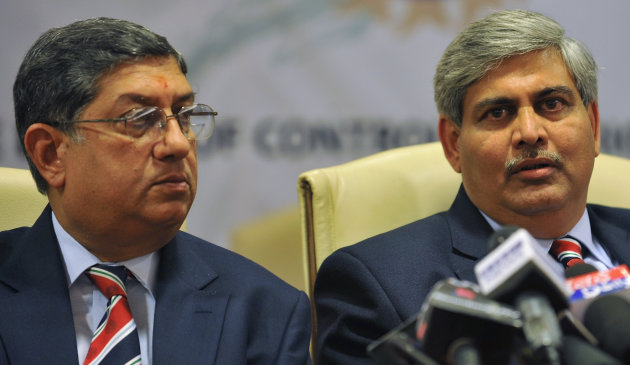Greed is in the IPL’s DNA. It won’t go away by banning five nondescript cricketers.
 The BCCI have fine-tuned the IPL ecosystem to make money. So why deprive uncapped players?
The BCCI have fine-tuned the IPL ecosystem to make money. So why deprive uncapped players?— TV mogul Kerry Packer, negotiating the TV rights with the Australian Cricket Board in 1976.
***
Before the start of IPL5, we at Yahoo! Cricket flirted with the idea of creating a rating system with help from our friends at Impact Index. The system would reveal a player’s real value per dollar paid to him by his team. It would be a Return on Investment (ROI) index with a difference.
There are other such indice around. The difference we were trying to make was not gauging a player’s utility by his runs or wickets tally alone. Instead, we would consider his Impact Index rating, which gives us a clearer picture of one player’s performance against the 21 other in the same match, while also factoring in match pressure and quality of opposition — variables that absolute numbers can never reveal.
Fabulous idea. Or so we thought.
Even before we’d begun, our idea hit a brick wall. It was a fundamental problem: how could we accurately tell you a player’s ROI if we didn’t even know what he was being paid?
We were in the dark about the salaries of a large number of Indian players. It was an open secret that off-the-book endowments were being made to IPL players in violation of the salary slabs prescribed by the IPL governing council. Going by official figures made little sense.
On one hand, the IPL claimed to be transparent and kosher. On the other, it created an environment that led to large-scale bending of its own rules. And if there was a sliver of doubt about these unethical practices, it was wiped away by the comments of the five players caught on tape negotiating off-the-book deals with undercover reporters posing to be player agents.
***
HOW DID WE COME TO THIS?
In IPL 2011 when teams were rebuilt from scratch, every squad needed a minimum of 20 Indian players (and a maximum of 10 foreigners). To field 10 teams, the IPL needed a minimum of 200 Indian players. Seven were retained by their teams; 48 were auctioned. This left a massive vacancy of 155, to be filled by buying uncapped players — those who haven’t represented India.
Twenty is a big number and would naturally cause teams to fall over each other as they rush to acquire the best Indians available. There would be a bigger dash to acquire IPL heavyweights such as Ambati Rayudu, Manish Pandey, Rajat Bhatia and the likes – players without an India cap, but those who have excelled in the IPL.
Now here’s where the trouble started. The BCCI refused to put these players up for auction. Instead, they had to be acquired through a three-way contract between the team, the player and the BCCI. This was, perhaps, a safety net to ensure that players were officially paid what their salary slab prescribed.
This led to a situation where two equally talented players — take Saurabh Tiwary and Manish Pandey for example — would be paid disparate salaries since one of them (Tiwary) had represented India, and the other hadn’t.
Tiwary, 21, was bought by Bangalore for a whopping $1.6 million. Pandey, also 21, the first Indian centurion in the IPL and a consistent scorer in domestic cricket, went to Pune for a puny $40,000.
***
JADEJA > TENDULKAR? IPL’S BLACK ECONOMY EXPLAINED
The effects of this disparity were felt in 2010 when Ravindra Jadeja was banned for a full season for trying to land himself a bigger deal outside Rajasthan Royals, who wanted to retain him. In 2011, Pandey was banned for four games for the same. It’s the players who suffered here, not the teams and their agents who encouraged this behaviour.
Later in 2012, Jadeja was purchased by Chennai for $2 million. Rumour has it that Chennai also paid an extra $4 million to acquire him through a tie-breaker bid — another one of BCCI’s ingenious schemes to keep those greedy, young rascals in their place while smartly pocketing the difference. In practical terms, this meant that from a humble $20,000 in 2008, Jadeja’s worth rose a staggering 300 times. Pandey’s salary barely increased. Or so it seemed.
Most of the players exposed by India TV’s sting operation revealed they were being made off-the-book payments — black money. One said Pandey had even been gifted an expensive car as part of his deal. It all made sense. The IPL market for Indian players is intensely competitive. Team owners will do everything they can to get the best players. Why would Pandey want to switch teams if there wasn’t a deal sweetener thrown in? Hence can you blame cricketers like Mohnish Mishra Shalabh Srivastava when they went seeking better pay packets? This is how every job market works.
But in this twisted economy created by the BCCI, a Sachin Tendulkar or an MS Dhoni (both paid $1.8 million, officially) is worth less than Jadeja, Yusuf Pathan, Robin Uthappa, Rohit Sharma and Irfan Pathan. We are expected to take the BCCI at face value for this.
When Sharad Pawar took over as the BCCI president in 2005, one of the things he had promised was to make BCCI’s operations transparent. Pawar gave way to Shashank Manohar, and he to N. Srinivasan. Seven years later, what levels of transparency are we talking about here?
Kudos to the BCCI for showing alacrity in suspending these five cricketers for their indiscretions. But the monstrous machinery that creates these cricketers is alive, lying low, waiting to hatch more trouble.
No comments:
Post a Comment